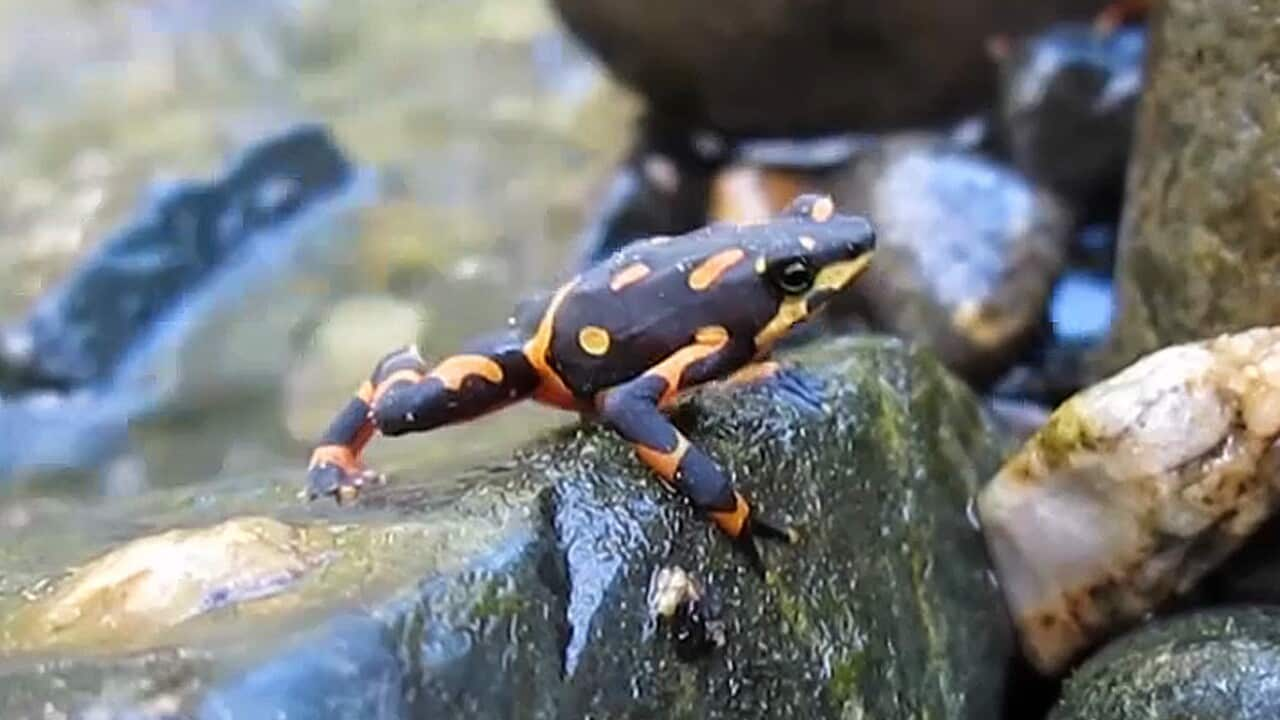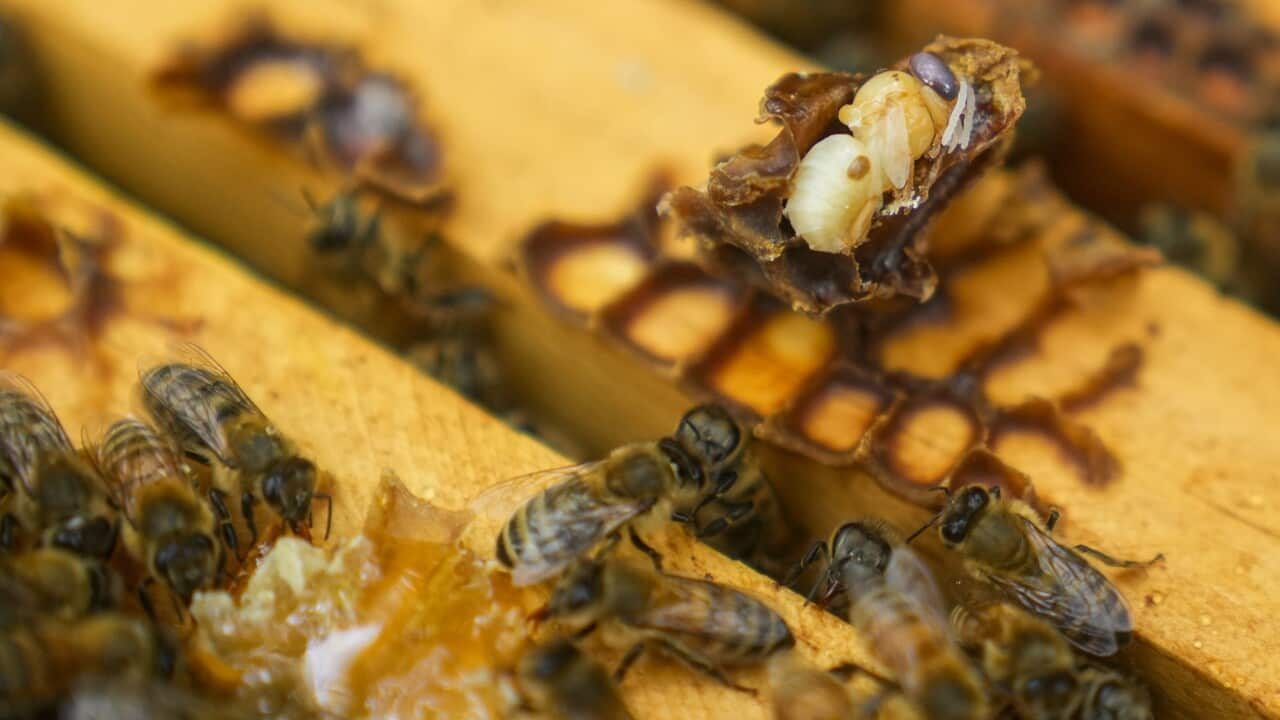Italian
UPSOT 1 - rain forest sounds
Siamo nel mezzo della notte nella foresta pluviale del Costa Rica nell’America centrale.
Lo specialista di specie anfibie in pericolo Juan Abarco sta cercando rane piccole e rare.
Ma non sta raccogliendo solo rane.
Quello che cerca è ciò che si trova sulla loro pelle.
Il dottor Adrian Pinto Tomas, del Centro per la ricerca in biologia cellulare e moleculare dell’Università del Costa Rica, spiega:
"The general objective of the research is to understand the problem of chytridiomycosis, that is, this disease caused by a parasitic fungus in amphibians, because it is one of the causes associated with the massive death of these organisms. For example the case of the Golden Toad in Monte Verde that we know in Costa Rica. There were reports of this parasite in many studies, but they were based only on its DNA. Our first major goal was to obtain it in pure culture, that is, to isolate the fungus responsible for this disease in amphibians. This is important because by knowing the enemy well we can develop strategies to combat and control it."
Nel 2019, uno studio condotto dalla Australian National University scoprì che la chitridiomicosi, una malattia causata da un fungo, aveva causato vertiginosi declini delle popolazioni di almeno 501 specie anfibie.
La malattia è responsabile dell’estinzione di 90 specie nel corso di un periodo di cinque decenni.
Ma gli scienziati del Costa Rica hanno scoperto che alcune popolazioni nella loro regione sono più resistenti al fungo galeotto e hanno deciso di indagare.
Gilberth Alvarado del Laboratorio di Patologia Sperimentale e Comparativa della scuola di Biologia dell’Università del Costa Rica, ha annunciato di sapere come il fungo ha compromesso gli anfibi:
"The chytrid fungus, when it manages to install in the skin of the animals and produce the disease, causes two lesions. There's a multiplication of the cells that it has in its skin and also a thickening of the Keratin layer that exists in the skin. The thickening of the skin of the animals affects the normal functionality of the skin of the amphibians which is very important for the respiration and exchange of water and other ions and molecules."
La squadra costaricana ha scoperto che un batterio presente sulla pelle di alcune rane e di altri anfibi può fermare il fungo dall’infettare la pelle di altri animali, da dove spinge le cellule a demolirsi.
Gli anfibi respirano attraverso la loro pelle e l’infezione è spesso mortale.
Juan Abarco ha dichiarato che, prendendo le rane dalla foresta, sperano di estrarre dalla loro pelle campioni del fungo e del batterio per poterli testare.
"The process is basically to obtain the fungus from the skin of amphibians, characterize it and then to also obtain the bacteria from some threatened amphibians. A third step is to grow the fungus with the bacteria to determine which of these bacteria had effectively inhibited and could prevent the growth of the fungus."
Il dottore Pinto Tomas ha dichiarato che la loro ricerca ha rivelato che il fungo è legato geneticamente al tipo di fungo che è stato associato con le morti degli anfibi in tutto il mondo.
E in più, hanno scoperto che alcune rane costaricane hanno dei batteri sulla loro pelle che hanno inibito il fungo e salvato le loro vite.
"Now in a next step we must continue to study the amphibian in its natural environment to find the best bacteria that can protect it from this disease."
Ora sperano che la scoperta dei batteri resistenti al fungo possa aiutare a proteggere gli anfibi, eventualmente tramite l’inoculuazione di batteri resistenti al fungo negli animali, prima di liberarli nella natura.
Secondo L’Unione Internazionale per la Conservazione della Natura, al momento ci sono 64 specie di anfibi classificati a rischio nel Costa Rica.
English
UPSOT 1 - rain forest sounds
It's the middle of the night in the rain forests of Costa Rica in central America.
Endangered amphibian species specialist Juan Abarco is looking for tiny, rare frogs.
But it's not just the frogs he's collecting.
It's what's on their skin.
Dr Adrian Pinto Tomas, of the Center for Research in Cellular and Molecular Biology of the University of Costa Rica, explains:
"The general objective of the research is to understand the problem of chytridiomycosis, that is, this disease caused by a parasitic fungus in amphibians, because it is one of the causes associated with the massive death of these organisms. For example the case of the Golden Toad in Monte Verde that we know in Costa Rica. There were reports of this parasite in many studies, but they were based only on its DNA. Our first major goal was to obtain it in pure culture, that is, to isolate the fungus responsible for this disease in amphibians. This is important because by knowing the enemy well we can develop strategies to combat and control it."
In 2019 a study led by The Australian National University ((ANU)) found that chytridiomycosis, a disease caused by a fungus, caused steep population declines in at least 501 amphibian species.
It's responsible for the extinctions of 90 species over a period of five decades.
But scientists in Costa Rica found that some populations in their region are more resilient to the fungus responsible and decided to investigate.
Gilberth Alvarado from the Laboratory of Experimental and Comparative Pathology of the School of Biology at the University of Costa Rica says they knew how the fungus affected the amphibians:
"The chytrid fungus, when it manages to install in the skin of the animals and produce the disease, causes two lesions. There's a multiplication of the cells that it has in its skin and also a thickening of the Keratin layer that exists in the skin. The thickening of the skin of the animals affects the normal functionality of the skin of the amphibians which is very important for the respiration and exchange of water and other ions and molecules."
The Costa Rican team found that a bacteria present on the skin of some frogs and other amphibians can stop the fungus infecting the skin of the animals, where it causes cells to break down.
Amphibians breathe through their skin and the infection is often deadly.
Juan Abarco says by collecting frogs from the forest, they hope to extract samples of the fungus and the bacteria from their skin for testing.
"The process is basically to obtain the fungus from the skin of amphibians, characterize it and then to also obtain the bacteria from some threatened amphibians. A third step is to grow the fungus with the bacteria to determine which of these bacteria had effectively inhibited and could prevent the growth of the fungus."
Dr Pinto Tomas says their research revealed that the fungus is genetically linked to the types of fungus that has been associated with the deaths of amphibians right around the world.
And they also discovered that some of the Costa Rican frogs had bacteria on their skin which inhibited the fungus and saved their lives.
"Now in a next step we must continue to study the amphibian in its natural environment to find the best bacteria that can protect it from this disease."
They now hope the discovery of the fungus resistant bacteria will help protect amphibians, possibly by inoculating animals with the fungus resistant bacteria before releasing them into the wild.
According to the International Union for Conservation of Nature, there are currently 64 amphibian species in Costa Rica in some category of risk.
Report by Allan Lee




